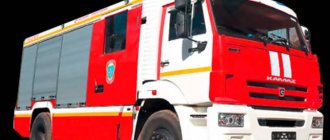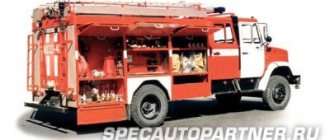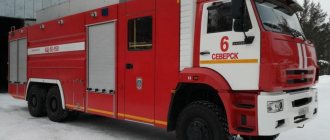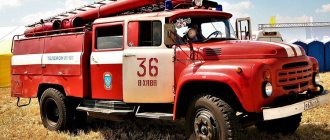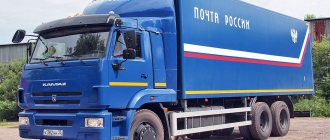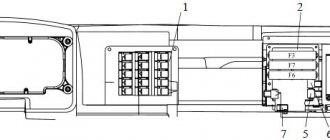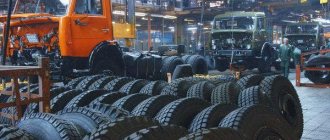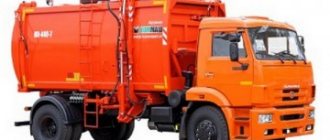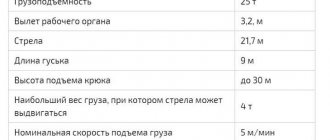- Home page »Products »Fire trucks »AC 3.2-40/4 KAMAZ 43253
ATs 3.2-40/4 on the KAMAZ 43253 chassis is designed to deliver personnel, fire extinguishing agents, fire-fighting equipment and rescue tools to the site of a fire.
Firefighting vehicles / Firefighting tankers
Fire tanker AC 3.2-40/4 (43265)
- Advantages
- Description
- Characteristics
- Corrosion-resistant materials of the tank, body, water-foam communications
- Balanced firepower supply
- Powerful pump
- High driving performance
- Remotely controlled fire monitor
- Spacious crew cabin
- Ease of maintenance
- delivery of personnel to the place of call
- extinguishing fires and carrying out emergency rescue operations using fire extinguishing agents, fire-technical weapons and emergency rescue equipment carried on it
- supplying fire extinguishing agents to the fire site from other sources, using both an independent combat unit and as a pumping unit when working “in pumping” with one or more fire trucks
| Chassis | KAMAZ 43265 |
| Wheel formula | 4x4 |
| Dimensions: length/width/height, mm | 8700/2550/3400 |
| Total weight, kg | 14500 |
| Turbocharged diesel engine | Cummins ICB6.7e5 285 |
| power, kW/hp | 209 (285) |
| Maximum speed, km/h | 90 |
| Stock of fire extinguishing agents | |
| water, l. | 3200 |
| foaming agent, l. | 200 |
| Pump (normal pressure stage) | |
| rated pump flow, l/s | 40 |
| nominal pressure, MPa | 1,0 |
| Pump (high pressure stage) | |
| rated pump flow, l/s | 4,0 |
| nominal pressure, MPa | 4,0 |
| Crew cabin type | double |
| Number of seats including driver | 6 |
© TPP Peleng LLC since 1995
This is interesting: First aid vehicle APP-1.0-40-2: description and performance characteristics
Overview of modifications
Any specialized equipment weighing up to 24 tons can be installed on the KamAZ chassis. The timber carrier for transporting logs and fallen trees to the storage site has superstructures and additional mechanisms with removable sides and steel rods.
Grain carrier Mammoth model 6520 with a capacity of 400 hp. With. used for transporting grain. The KamAZ body is a container in the form of a tank or bunker.
The multilift transports scrap metal and construction waste.
A concrete mixer is a chassis with a rotating container for transporting concrete. It is also called a concrete mixer or mixer.
designed for harvesting. The main differences are:
- lateral unloading;
- higher sides;
- the presence of a tow bar for an additional trailer.
Depending on the type of unloading, configuration and volume of the platform, the following modifications of machines are distinguished:
- Model 6520-006 is an onboard KamAZ-6520 dump truck with a rear unloading type, which has become a leader in the model range thanks to a reliable ZF gearbox and a 320 hp engine. With. Euro-2 class. The platform volume is 12 m³.
- The KamAZ-6520-06 dump truck has a body volume of 10 m³ and rear unloading. Cabin with high roof. Diesel with a capacity of 360 hp. With. Euro-2.
- 6520-029 with a dump platform with a volume of 20 m³ and unloading, like previous models. Often used in road construction and quarries.
- Heavy truck 6520-6010-29 (K4) - 3-axle with rear unloading and an oval body section of 16 m³. The platform is all-metal, scoop type, without heating, welded. A safety bar is attached to the rear of the frame.
- KamAZ-6520-6030-73 is a restyled model of a dump truck with 2-sided side unloading and a body volume of 30 m³. The rear side is hinged, the top extension is removable.
- KamAZ-6520-6041-43 is a 3-axle dump truck with rear unloading and a body of 16 m³. The cabin is located above the Euro-4 class engine, without a berth. The car is equipped with a Russian standard tachograph with a CIPF unit.
- The body of the dump truck 6520-6012-43 is rectangular in shape and provides a rear type of unloading. The unheated platform holds 20 m³ of bulk materials. The cabin is restyled, comfortable with air suspension.
- 6520-21010-43 “Lux” with a 16 m³ platform is heated by exhaust gases. The truck is equipped with a Euro-5 engine with a pre-heater. Cabin with air conditioning, auxiliary heater, electronic tachograph and audio equipment - radio antenna and 2 speakers. The cabin air suspension is 4-point, spring.
- The KamAZ-6520-61 chassis is available in 2 versions with a wheelbase of 3600 mm and 4600 mm. The curb weight is 9200 and 9850 kg, respectively. The KamAZ truck tractor tows trailers weighing no more than 20 tons on hard roads. The model is equipped with a powerful Euro-3 engine, which is combined with 2 manual transmission options - a 10-speed KamAZ-154 or a 16-speed German ZF-16S151.
- Chassis 6520-3072-43 is designed for mounting special equipment using a “pin-and-loop” towing device of the Euro towbar type. The machine is equipped with a Euro-4 eco-class engine, interwheel and axle locks, and a Common Rail fuel system. Cabin with air suspension and tachograph.
Performance Variations
The KamAZ-43253 chassis and the version of the car with sides have similar technical characteristics. The index assigned to the car at production is 43253-69 (G5).
The universal chassis is oriented and adapted for the installation of all kinds of special equipment. Therefore, the vehicle is often used as a truck crane, tank truck, garbage truck, concrete mixer, feed loader, etc.
The fire-fighting version of the KamAZ-43253 is in high demand, the technical characteristics of which make it possible to effectively operate in such a specific industry.
The flatbed truck as standard has a platform (5162 by 2470 mm) with sides 1425 mm high, made of sheet steel and capable of folding down. It is also possible to equip it with a steel frame and awning. This modification can be used to form a road train that uses a GKB-8350 trailer of a similar size to a truck.
Coating
The site and dead-end driveway must have a surface suitable for the movement of special equipment at any time of the year. The coating itself must have sufficient strength to withstand the load of a fully loaded vehicle, which is 46 tons and the load on each axle is up to 15.5 tons.
Soft ground makes it difficult for vehicles to move and turn. If turns are installed in areas with sandy or clayey soils, it is recommended to strengthen them with slag, crushed stone, and other available building materials.
A slight slope is also necessary. It is formed so that water formed after rains or heavy snowfalls can drain by gravity, and does not exceed 6 degrees.
The contour of the turning platforms is treated with an antiseptic composition, after which it is equipped with water collectors and drainage holes. In areas with curves, curved side stones are additionally installed.
Fire tanker AC 3.2-40/(43206)
A modern fire truck with improved tactical and technical characteristics. The tanker is built on a highly cross-country Ural 43206 chassis with a 4x4 wheel arrangement.
The tank truck has powerful lighting equipment, a modern fire monitor with remote control, and convenient compartments for fire protection equipment.
A modern, ergonomic car with a cabover cab and a two-stage pump NTsPK 40/100-4/400. Manufactured on the basis of the URAL-43206-4151-81 chassis, with a 4x4 wheel arrangement and the ability to install an in-vehicle emergency call device.
- The crew cabin has mounts for breathing apparatus with compressed air for firefighters.
- In the cab, on the front panel of the driver, there is an information device with a display that displays an indication of open cab doors, compartments for fire-fighting equipment, an indication of the level of water and foam concentrate, an indication of the operating time (pump, chassis), and allows you to control special sound and light signals installed on the AC cab with duplication on the radiator grille.
- The tank and foam tank are made of polymer materials with an extended service life. Remotely controlled monitor, both from the cabin and from the pump compartment.
- The AC is equipped with a lighting mast with a pneumatic drive for lifting spotlights with a total power of 2 kW. The height of the lighting mast is 5 meters.
- Parking system for monitor and mast. Full remote control of the pumping unit, incl. from the driver's cabin.
- The fire pump has an additional cooling circuit to provide improved cooling of the base chassis engine in the summer and for additional heating of the fire extinguishing agents in the pump in the winter.
- The fire pump has an automatic foam dosing system that provides 3% and 6% foam solutions in all fire pump flow and pressure ranges.
- A combined-action pump installation allows extinguishing both with conventional weapons and with the help of high-pressure equipment that generates finely atomized water jets. To control the pumping unit, a modern control and monitoring system is used on touch screens, with a large range of automatic functions that make the operator’s work as easy as possible.
- The chassis is equipped with a front electric winch with a traction force of 6.8 tons. The chassis is equipped with an electro-pneumatic clutch drive for turning on/off the power take-off from the pump compartment and driver's cabin.
- There is a 60 m high pressure hose reel, a lighting mast, and a winch. Automatic foam mixing and water filling systemHigh corrosion resistance of the fire crew body and cabin is achieved by manufacturing them from aluminum and plastic.
- The AC superstructure is an independent structure made of aluminum sheet and plastic using adhesive technology. The roof of the superstructure is covered with a special coating that prevents slipping.
| Basic characteristics | |
| Basic chassis | URAL-43206-4151-81 |
| Wheel formula | 4x4 |
| Diesel engine | YaMZ-53623 |
| Rated power, kW (hp) | 200.7 (273) |
| Maximum speed, km/h | 85 |
| Fire crew, persons | 6 |
| Water tank volume, l | 3200 |
| Foam tank volume, l | 200 |
| Pump location | rear |
| Flow in nominal mode l/sec. | 40/4 |
| Head, m | 100/400 |
Dealer map
Our company has a wide dealer network. You can find a dealer of our products in any region of Russia.
More details
Financial services
Our company cooperates with leading leasing companies for the purchase of specialized equipment.
More details
Service and guarantees
The company guarantees service (service) for UMG products in any region of Russia and abroad through a proprietary dealer service network.
More details
8 Passages, driveways and entrances to buildings and structures
8.1 Access for fire trucks must be provided:
– from two longitudinal sides – to buildings and structures of functional fire hazard class F1.3 with a height of 28 meters or more, functional fire hazard classes F1.2, F2.1, F2.2, F3, F4.2, F4.3, F .4.4 with a height of 18 meters or more;
– from all sides – to buildings and structures of functional fire hazard classes F1.1, F4.1.
8.2 Access to fire fighting vehicles must be provided to buildings and structures of production facilities along their entire length:
– on the one hand – with a building or structure width of no more than 18 meters;
– on both sides – when the width of the building or structure is more than 18 meters, as well as when constructing closed and semi-enclosed courtyards.
8.3 It is allowed to provide access for fire trucks to buildings and structures only on one side in the following cases:
– lower height than specified in paragraph 8.1;
– two-way orientation of apartments or premises;
– installation of external open staircases connecting loggias and balconies of adjacent floors with each other, or type 3 staircases in the corridor layout of buildings.
8.4 For buildings with a built-up area of more than 10,000 square meters or a width of more than 100 meters, fire truck access must be provided from all sides.
8.5 It is allowed to increase the distance from the edge of the roadway to the nearest wall of industrial buildings and structures to 60 meters, provided that dead-end roads are constructed to these buildings and structures with areas for turning fire equipment and fire hydrants are installed on these areas. In this case, the distance from industrial buildings and structures to sites for turning fire equipment should be at least 5, but not more than 15 meters, and the distance between dead-end roads should be no more than 100 meters.
8.6 The width of passages for fire fighting equipment, depending on the height of buildings or structures, must be at least:
– 3.5 meters – with a building or structure height of up to 13.0 meters inclusive;
– 4.2 meters – with a building height from 13.0 meters to 46.0 meters inclusive;
– 6.0 meters – with a building height of more than 46 meters.
8.7 The total width of the fire passage combined with the main entrance to the building and structure may include a sidewalk adjacent to the passage.
8.8 The distance from the inner edge of the passage to the wall of the building or structure should be:
for buildings up to 28 meters high inclusive - 5-8 meters;
for buildings more than 28 meters high - 8-10 meters.
8.9 The design of the pavement of passages for fire fighting equipment must be designed for the load from fire fighting vehicles.
8.10 In closed and semi-enclosed courtyards, it is necessary to provide passages for fire trucks.
8.11 Through passages (arches) in buildings and structures must be at least 3.5 meters wide, at least 4.5 meters high and located no more than every 300 meters, and in reconstructed areas when building along the perimeter - no more than every 180 meters.
8.12 In the historical development of settlements, it is allowed to maintain the existing dimensions of through passages (arches).
8.13 Dead-end driveways must end with areas for turning fire equipment measuring at least 15 x 15 meters. The maximum length of a dead-end driveway should not exceed 150 meters.
8.14 Through passages through stairwells in buildings and structures are located at a distance of no more than 100 meters from one another. When buildings and structures adjoin at an angle to each other, the distance along the perimeter from the side of the external water supply with fire hydrants is taken into account.
8.15 When using the stylobate roof for access to fire fighting equipment, the stylobate structures must be designed for a load from fire trucks of at least 16 tons per axle.
8.16 Rivers and reservoirs must be accessible for fire equipment to collect water in accordance with the requirements of fire safety regulations.
8.17 The planning solution for low-rise residential buildings (up to 3 floors inclusive) must ensure access of fire fighting equipment to buildings and structures at a distance of no more than 50 meters.
8.18 On the territory of a gardening, vegetable gardening and dacha non-profit association of citizens, fire fighting equipment must be provided with access to all garden plots combined into groups and public facilities. On the territory of a horticultural, gardening and dacha non-profit association of citizens, the width of the carriageway of streets must be at least 7 meters, driveways - at least 3.5 meters.
16-03-2016 27 474
3
Advantages of AC 3.2-40/based on KAMAZ 43253 chassis
- The fire superstructure is made using AT technology (“Aluminum Technology”).
- The double ergonomic crew cabin (CBC) is designed for 6 people. All seats in the crew compartment of the cockpit are removable and equipped with built-in mounts for compressed air breathing apparatus (CABR) of all types. The steps and handrails of the KBR extend automatically and provide free entry and exit for the combat crew when fully equipped, including DASV.
- The elements of the superstructure (fire pump, fire monitor, steps and handrails, flashing lights, etc.) are controlled remotely by the driver from the control unit and the pump compartment through the electronic control system (LCS).
- To ensure work with removable manual fire escapes and suction hoses, there are devices for lowering and installing ladders and suction hoses.
- The AC is equipped with a centrifugal combined fire pump NH25/N25 with an automatic foam mixing system FIX-MIX complete with a high-pressure hose reel (60 m) and a NEPIRO-ERGO high-pressure spray barrel. The pumping unit is equipped with a protective heat and noise insulating casing.
- To avoid corrosion and ensure a long service life, the water tank is made of polypropylene and (or) fiberglass. The foam tank can be used for storing and transporting all types of foaming agents.
- An RM 24M monitor with manual control or an RM 25E with remote control can be installed on the roof of the AC. The productivity of the trunks is 40 l/sec at a pump pressure of 10 bar. The water jet supply range is 70 meters.
New equipment
Most of the vehicles in service with the GPS use traditional extinguishing agents: water, foam, powder, or work according to a combinatorial scheme. Some companies are developing innovative installations that make it possible to generate compression foam. These are the Natisk systems, CAFS with its variations, Hiromax. One of the leaders in this direction is considered to be from Yekaterinburg. The company has 10 vehicles equipped with the Na-Tisk system, which is a modified CAFS.
Thanks to modernization, the use of cars in the northern regions has become possible. Controlled samples showed that the efficiency of water consumption there increased by 7 times. The system operates even at temperatures of -60°C. Compression foam is supplied through Na-Tisk to a height of up to 200 m. Experiments have confirmed that the foam lasts up to 1.5 hours on wooden surfaces and up to 1 hour on metal surfaces.
The firefighters themselves appreciated the new system. They note that sleeves filled with compression foam are several times lighter than those that work with water. This increases maneuverability when extinguishing fires and reduces physical stress on fighters.
Service
The design of this car, in general, is quite thoughtful. However, some points could have been worked out more carefully. Among the obvious shortcomings that surfaced during operation, it is worth highlighting the following:
- The control unit fuse often blows - this problem is usually associated with a short circuit and is determined by the classic “ringing” using an ohmmeter.
- Diagnostic connector pinout required. Attached is a diagram.
- Not the best location of the accelerator sensor. Nothing can be done here - this is a flaw of the design engineers. Unfortunately, in our auto industry we cannot live without this.
There are other minor complaints against the manufacturers.
Design Features
Compared to its predecessor, KamAZ 43253 has some features. In particular, it is smaller in size. The chassis length is 7,425 mm, and the onboard version is 7,505 mm. Also, this truck, if necessary, is equipped with additional equipment, including such as a cross-axle differential lock and a power take-off for attachments, if any.
There are custom-made modifications that are adapted to difficult and extreme operating conditions: at ambient temperatures from -40 to +50 degrees Celsius, dust levels up to 1.5 g per 1 cubic meter.
Flatbed version and universal chassis
The universal chassis is designed for special vehicles, such as concrete mixers, truck cranes and so on. Often, within urban operating conditions, KamAZ 43253 vehicles are used in fire services and housing and communal services.
Onboard options are also quite common. The side platform has folding sides with a height of 0.73 m as standard. If the customer wishes, they can be increased. The internal dimensions of the onboard platform are 5,162 mm by 2,470 mm. At the same time, the loading height is 1,425 mm.
Cabin KamAZ 43253
All models of this manufacturer are equipped with standard cabins, which are licensed by the German concern Mercedes. They can be with a high or low roof. A sleeping place, as already noted, is not provided. At the same time, the cabin has four mounting points for the air suspension. This is very convenient from a practical and ergonomic point of view.
The driver and passenger seats are conveniently adjustable in four directions (in practice, this turns out to be quite enough); you can also adjust the steering column, both in height and inclination angle. By the way, the steering itself is equipped with an effective and truly “working” power steering.
Design and interior
The cabin uses really high-quality materials to create a feeling of comfort. The developers thought through the location of sensors, control devices, and information boards. All of them are located so as not to distract the driver from driving the vehicle.
The modern look of the truck is given by: a large windshield with three cleaning brushes, a new bumper and an original radiator grille. The hanging elements are usually painted the same color as the cabin.
This is interesting: Engineering barrier vehicle (IMR)
What to do with stripes of the wrong size
Indeed, in the event of an accident, traffic police officers and the judge will look at the actual condition of the roadway, and not at the theoretical one.
However, in some cases it makes sense to “deal with” incorrect markings on the roadway.
For example, outside populated areas I happened to encounter a traffic lane that gradually narrowed and eventually its width was about 1.5 meters. Naturally, cars did not fit in such a lane and they had to partially move into the neighboring one.
If you encounter something similar in practice, then the problem can be solved. And it's not very difficult. To do this, just write an appeal to the local organization involved in road maintenance. And the most difficult thing is to find this organization, because... Each region uses its own name.
However, if you have any difficulties at this stage, then simply write an appeal to the local administration (city, district, prefecture, etc.). In the text of the appeal you can indicate the following:
Near house 18 on Lenin Street in Moscow there is a continuous marking line. At the same time, the width of the extreme right lane (direction to the center) is 2.24 meters and this value does not comply with the requirements of SNiP 2.07.01-89.
I ask you to correct the traffic organization in this area (apply new markings).
Such an appeal is a good way to correct the shortcomings of traffic management.
MAIN CHARACTERISTICS
| Basic chassis | KAMAZ 43253 |
| Wheel formula | 4x2 |
| engine's type | Cummins 6 ISBe 185, Euro 4 |
| Engine power | 210 hp (150 kW) |
| Combat crew | 6 |
| Water tank capacity | 3200 liters |
| Foam tank capacity | 200 liters |
| Fire pump | NH25/N25 |
| Pump capacity | 40 l/sec at 10 Atm, when the high pressure stage is operating - 4.2 l/sec at 40 Atm |
| Full mass | 15500 kg |
Scope of use
The chassis is manufactured for installation of various vehicle options:
- vans;
- garbage trucks;
- excavators;
- fuel tankers;
- truck cranes;
- aerial ladders;
- concrete mixers;
- drilling rigs, etc.
Special equipment is also installed on all-wheel drive chassis from this manufacturer, for example, this applies to dump trucks, shift buses, and concrete mixer trucks. For such vehicles, any road conditions will not be a problem due to their increased cross-country ability. Because of this, gas and oil industry technicians use all-wheel drive chassis from KAMAZ. These vehicles are affordable and reliable, so they are always in demand. They can be used in various climates and weather conditions. They are able to withstand from +400C to -400C, an increase in air humidity up to 80%, wind speeds up to 20 m per second and excessive dust up to 1 g per m3. Cars can easily be driven in the mountains at an altitude of up to 3,000 m above sea level.
Against a fire avalanche: fire trucks
BET ON PROGRESS
Initially, SP "SP" relied on the production of machines that were not inferior to the best foreign analogues. The company's products, located on the territory of AMO ZIL, differ from other Russian competitors in their progressive technical solutions.
Today, the company’s product line includes multifunctional firefighting tankers with a capacity of 2 to 8 thousand liters on KAMAZ and MAN chassis, rescue vehicles, airfield vehicles, and a special VGSCH vehicle on the MAN TGM 13 chassis.
250 4x4 BL for transporting mountain rescue units and other types of fire equipment.
Fire and rescue vehicle AC 3.2-40/4 on KAMAZ-5387 chassis
Among the latest developments, we can note the fire and rescue vehicle AC 3.2-40/4 on the chassis (4x4) KAMAZ-5387 or MAN TGM 13.290. The cars are used both off-road and in dense city traffic.
The water tank with a capacity of 3200 liters is made of polypropylene, and the foam tank with a capacity of 200 liters is resistant to any type of foaming agent. The model is equipped with a pump with normal and high pressure stages, as well as an automatic foam mixing system complete with a high-pressure hose reel (60 m).
An electronically controlled monitor with a capacity of 40 l/s at a pressure of 10 bar is installed on the roof. The water jet supply range is 70 m.
The kit includes an electric winch with a traction force of 6 tons, LED flashing lights, rear lighting, LED lighting for the fire-fighting equipment (FTV) compartments and the front of the vehicle. Retractable footrests with anti-slip properties are used for boarding and disembarking firefighters.
The pneumatic telescopic floodlight lighting mast, resistant to wind loads up to 15 m/s, is equipped with LED spotlights.
A finder headlight on the dashboard and LED spotlights on the gallery increase the illumination radius of the work area. LED reversing lights on the mirrors improve visibility when parking at night.
There is a reversing camera with a display in the driver's cabin.
Fire pump installation
Another new product, ASA-30-0.8-0.6, is a symbiosis of a firefighter and emergency rescue vehicle. It is used to extinguish primary fires with water and foam, work in emergency zones, eliminate the consequences of road accidents and provide first aid. The model is equipped with a high-pressure pump, a crane and a winch with a traction force of up to 6.5 tons.
The 30 kVA electric power plant allows the ASA to be used as an independent power source. The volume of the water tank (800 l) and foam tank (120 l) is sufficient to quickly extinguish the fire before the arrival of the main crews. A pneumatic telescopic mast with 6 LED spotlights is installed on the roof of the machine for operation in poor visibility.
Advice
In 2022, a first aid fire truck APP-2-0.3/100 model 023-MS appeared on the UAZ-23602 (4x4) “Cargo” chassis.
The compact model, equipped with a pump and containers for liquid fire extinguishing agents, is capable of delivering personnel and fire-fighting equipment to the site of a fire (accident), extinguishing fires in the initial stage, performing priority rescue operations and providing assistance to victims. The vehicle can move on off-road roads, narrow streets, and in closed areas of suburban settlements where the access of heavy equipment is difficult.
Width of the roadway according to GOST
The width of one lane depends on many parameters:
- where is the road - city, outside the city;
- maximum speed on a given route;
- number of lanes;
- the significance of the route is federal, republican, local.
The maximum bandwidth in Russia is 3.75 meters. These are:
- high-speed highways (up to 130 km/h), with 4-8 lanes in both directions;
- main city streets, designed for speeds up to 100 km/h, 4-8 lanes.
GOST also states that the total width of such a highway (4 lanes in both directions) should be 15 meters. This does not take into account dividing structures and curbs. If we are talking about an 8-lane highway, the width of the roadway should be, accordingly, 30 meters.
If we consider that the width of an average passenger car is 1.8 meters, then two cars could pass in one lane, but it would be a very tight passage.
Also, according to the same GOST, a width of 3.5 meters is allowed. This category includes:
- main roads with controlled traffic, designed for a speed limit of no more than 80 km/h, and consisting of 2-6 lanes in both directions;
- city roads, with controlled traffic, speed limits up to 80 km/h and a number of lanes from four to eight;
- transport and pedestrian roads of regional significance (with a curb for pedestrians), speed limit no more than 70 km/h, 2-4 lanes;
- streets and driveways leading to various transport, manufacturing or scientific enterprises where there is heavy traffic of trucks.
That is, on the central streets of cities where there are traffic lights, separate sidewalks for pedestrians, the width of one lane must be at least 3.5 meters.
Well, the narrowest roads are 3 meters wide. Although there is a special requirement that in case of repair work or due to the disgusting condition of the road, the width of the lane can be reduced to 2.75 meters.
The movement of vehicles on roads narrower than 2.75 meters is prohibited. As a rule, these are various bicycle or pedestrian paths, special entrances and exits from adjacent areas for special equipment. This rule may not apply to transport of city utilities or to vehicles for delivering goods, and so on.
The following types of roads can have a width of 3 (2.75) meters:
- streets in residential areas;
- driveways in parks or industrial zones (not main, but auxiliary);
- secondary roads leading, for example, to remote urban settlements.
Cabin design features
The truck in question is equipped with a licensed Mercedes cabin, which in the basic version does not have a berth. It is mounted on the 4-point air suspension used to equip the Mercedes-Benz Axor.
The cabin, installed on all new products of the Kama Automobile Plant since 2010, has a high level of comfort and can have a high or low roof. The original suspension design has a positive effect on the smoothness of the ride, while at the same time preventing cab sway and reducing vibrations during driving.
The position of the cabin, namely its height, is kept at a constant level, which is not affected by the degree of loading of the vehicle. The driver's seat is also equipped with pneumatics and lateral support.
The position of all seats in the cabin can be adjusted, for which four levels of adjustment are provided. This solution, coupled with the suspension of the cabin itself, provides a high level of comfort.
The steering column tilt and height adjustment function, implemented through pneumatic control, is also convenient for the driver. The steering wheel is equipped with a modern hydraulic booster.
The modernization of the truck cabin also affected its interior decoration. Thus, the quality of the materials used has increased significantly, and the plastic panels have acquired softness and pliability. The instrument panel design has become more modern. and she herself received anti-reflective glass.
The indicators, sensors and screen that are placed on it are informative and easy to read, which allows the operator to read the necessary data about the condition of the car without stopping from driving.
The plastic handles on the cabin doors received new integrated locks, as well as protection in the form of deflectors. There are fairings installed on the sides of the cabin, which are designed to reduce air turbulence and prevent contamination of the rear-view mirrors.
The latter are distinguished by new brackets where the main, curb, sliding and spherical mirrors are mounted, which guarantees the best possible visibility.
The optics of the car have also changed. Headlights, turn signals and side lights now form a single unit, providing excellent visibility and visibility. Three windshield wipers ensure the cleanness of the monolithic windshield.
The new cabin, unlike its predecessor, has a molded plastic (rather than steel) bump stop. The footrests are equipped with special pads that prevent slipping, ensuring safe lifting of the driver and passenger, regardless of weather conditions.
Taking into account the terrain when constructing paths
Any path laid on a site for practical or decorative purposes must be safe and also convenient to use. This is only possible if the paths are designed taking into account the terrain features of the site:
- Smooth terrain: secondary paths can be placed in any way (fan-shaped, in the form of branches from the main path, other options).
- “Saucer-shaped” relief: garden paths extend in rays of sunlight from the lowest place on the site in which a decorative pond or gazebo is located.
- Relief with a difference in height: on gentle slopes, garden paths are arranged in a zigzag shape, the neighboring sections of which are connected by smooth transitions. On steep slopes, it is impossible to do without installing retaining walls and terraces, the transition to which is provided with the help of ramps and stair steps.
The main garden path, immersed in the greenery of trees and stretching into the distance, allows you to climb to the terrace via a cascade of stairs
Advantages and disadvantages
The advantages of KAMAZ-43253 include the following features:
- Simple design. Thanks to this, it has a huge number of different modifications
- Good handling
- Good driving dynamics
- Large cargo compartment
- Increased visibility from the cab
- Maintenance on this truck is low cost
- Despite the fact that the interior has become more comfortable, relatively low-quality materials are used in its decoration.
- Truck design is outdated
- The truck has average reliability
- The truck does not meet standards to ensure the safety of the driver and passengers
Despite some shortcomings, KAMAZ 43253 is a worthy representative of the iconic truck brand. Like its predecessors, it is cheap, unpretentious, easy to operate, and also has a lot of options: from an onboard tractor to a dump truck. Thanks to these qualities, this vehicle is popular among cargo carriers in Russia and neighboring countries.
Other standards
There are also sanitary standards for the minimum gaps between the fence and:
- toilet in a country house in rural areas - 1 m;
- an enclosure for animals in a village on a summer cottage - 4 m;
- bathhouse in the private sector of individual housing construction - 1 m;
- medium-sized trees in SNT and individual housing construction - 2 m.
They can be seen more clearly in the diagram.
Permitted distances from buildings, trees and shrubs to the fence
Spaces that are defined by law are justified and determined by technical necessity. A blind area should be built around the house. All kinds of communications should be located. There must be a proper gap between the fence and the house.
Local regulations may differ from federal regulations. As a rule, this happens due to climatic and other characteristics of the region. Often the area of land does not make it possible to maintain the distance that is prescribed in the rules and regulations. If these conditions exist, a retreat of 1 meter or more is still necessary.
Minimum distances on the site between buildings according to the standards
If moving the fence creates uncomfortable conditions for transport or the population, the transfer of land will be refused. If the answer is yes, then, having paid for additional meters, you can begin to register the territory as your property. It is better to follow the legal route to avoid quarrels with neighbors and authorities.
